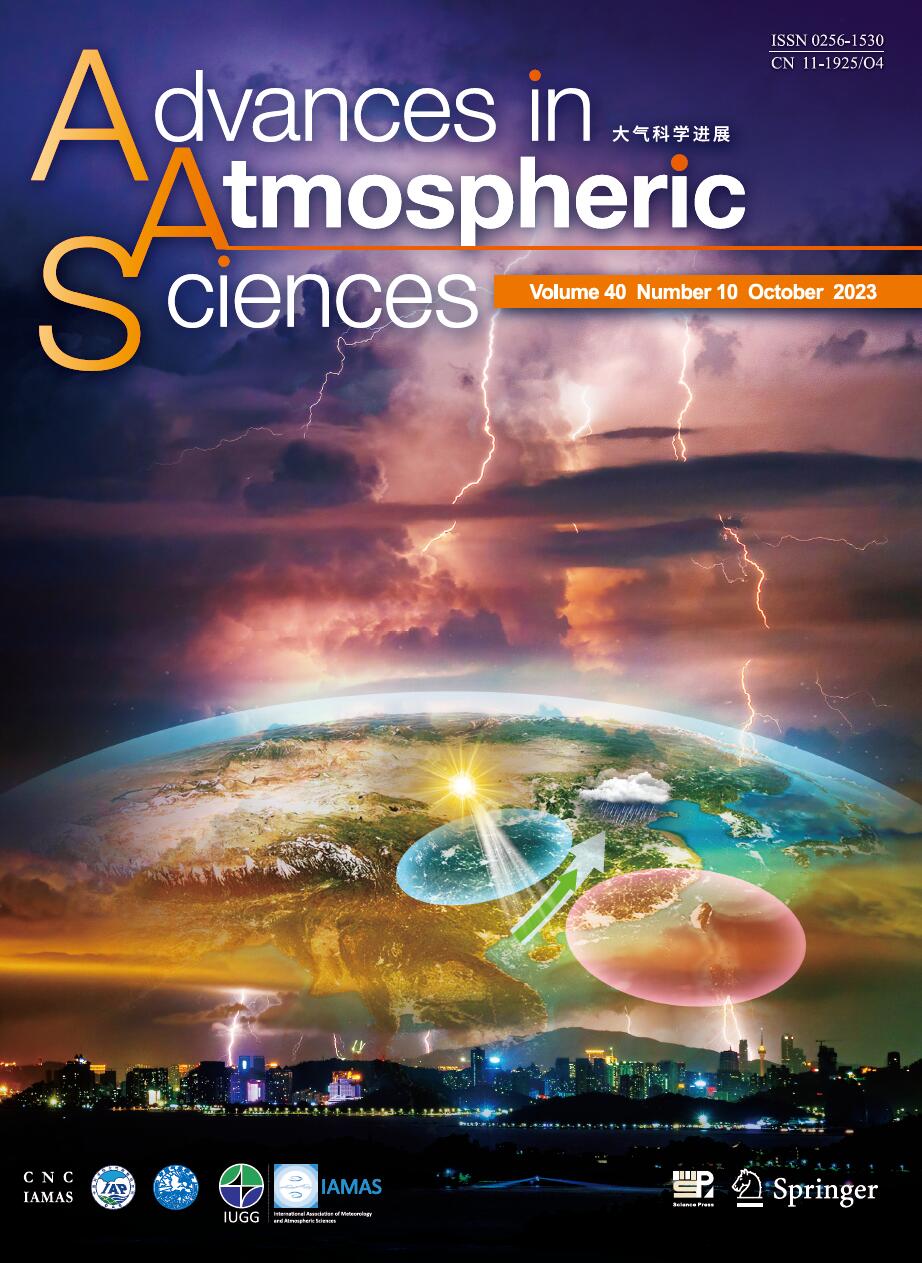| [1] |
XIONG Zhe, WANG Shuyu, ZENG Zhaomei, FU Congbin,
2003: Analysis of Simulated Heavy Rain over the Yangtze River Valley During 11-30 June 1998 Using RIEMS, ADVANCES IN ATMOSPHERIC SCIENCES, 20, 815-824.
doi: 10.1007/BF02915407
|
| [2] |
XIONG Zhe, FU Congbin, ZHANG Qing,
2006: On the Ability of the Regional Climate Model RIEMS to Simulate the Present Climate over Asia, ADVANCES IN ATMOSPHERIC SCIENCES, 23, 784-791.
doi: 10.1007/s00376-006-0784-9
|
| [3] |
Dan WANG, Aihui WANG, Lianlian XU, Xianghui KONG,
2020: The Linkage between Two Types of El Niño Events and Summer Streamflow over the Yellow and Yangtze River Basins, ADVANCES IN ATMOSPHERIC SCIENCES, 37, 160-172.
doi: 10.1007/s00376-019-9049-2
|
| [4] |
LI Weiping, XUE Yongkang,
2005: Numerical Simulation of the Impact of Vegetation Index on the Interannual Variation of Summer Precipitation in the Yellow River Basin, ADVANCES IN ATMOSPHERIC SCIENCES, 22, 865-876.
doi: 10.1007/BF02918686
|
| [5] |
LI Mingxing, MA Zhuguo,
2010: Comparisons of Simulations of Soil Moisture Variations in the Yellow River Basin Driven by Various Atmospheric Forcing Data Sets, ADVANCES IN ATMOSPHERIC SCIENCES, 27, 1289-1302.
doi: 10.1007/s00376-010-9155-7
|
| [6] |
GAO Rong, DONG Wenjie, WEI Zhigang,
2008: Simulation and Analysis of China Climate Using Two-Way Interactive Atmosphere-Vegetation Model (RIEMS-AVIM), ADVANCES IN ATMOSPHERIC SCIENCES, 25, 1085-1097.
doi: 10.1007/s00376-008-1085-2
|
| [7] |
Xianhong MENG, Shihua LYU, Zhaoguo LI, Yinhuan AO, Lijuan WEN, Lunyu SHANG, Shaoying WANG, Mingshan DENG, Shaobo ZHANG, Lin ZHAO, Hao CHEN, Di MA, Suosuo LI, Lele SHU, Yingying AN, Hanlin NIU,
2023: Dataset of Comparative Observations for Land Surface Processes over the Semi-Arid Alpine Grassland against Alpine Lakes in the Source Region of the Yellow River, ADVANCES IN ATMOSPHERIC SCIENCES, 40, 1142-1157.
doi: 10.1007/s00376-022-2118-y
|
| [8] |
Pavla PEKAROVA, Jan PEKAR,
2007: Teleconnections of Inter-Annual Streamflow Fluctuation in Slovakia with Arctic Oscillation, North Atlantic Oscillation, Southern Oscillation, and Quasi-Biennial Oscillation Phenomena, ADVANCES IN ATMOSPHERIC SCIENCES, 24, 655-663.
doi: 10.1007/s00376-007-0655-z
|
| [9] |
LIU Guimei, WANG Hui, SUN Song, HAN Boping,
2003: Numerical Study on the Velocity Structure around Tidal Fronts in the Yellow Sea, ADVANCES IN ATMOSPHERIC SCIENCES, 20, 453-460.
doi: 10.1007/BF02690803
|
| [10] |
Xiangzhou SONG†, Rui Xin HUANG, Dexing WU, Fangli QIAO, Guansuo WANG,
2019: Geostrophic Spirals Generated by the Horizontal Diffusion of Vortex Stretching in the Yellow Sea, ADVANCES IN ATMOSPHERIC SCIENCES, 36, 219-230.
doi: 10.1007/s00376-018-8091-9
|
| [11] |
REN Shihe, XIE Jiping, ZHU Jiang*,
2014: The Roles of Different Mechanisms Related to the Tide-induced Fronts in the Yellow Sea in Summer, ADVANCES IN ATMOSPHERIC SCIENCES, 31, 1079-1089.
doi: 10.1007/s00376-014-3236-y
|
| [12] |
Peter CHU, CHEN Yuchun, Akira KUNINAKA,
2005: Seasonal Variability of the Yellow Sea/East China Sea Surface Fluxes and Thermohaline Structure, ADVANCES IN ATMOSPHERIC SCIENCES, 22, 1-20.
doi: 10.1007/BF02930865
|
| [13] |
GAO Shanhong, LIN Hang, SHEN Biao, FU Gang,
2007: A Heavy Sea Fog Event over the Yellow Sea in March 2005: Analysis and Numerical Modeling, ADVANCES IN ATMOSPHERIC SCIENCES, 24, 65-81.
doi: 10.1007/s00376-007-0065-2
|
| [14] |
Ki-Young HEO, Kyung-Ja HA,
2008: Snowstorm over the Southwestern Coast of the Korean Peninsula Associated with the Development of Mesocyclone over the Yellow Sea, ADVANCES IN ATMOSPHERIC SCIENCES, 25, 765-777.
doi: 10.1007/s00376-008-0765-2
|
| [15] |
Jiwon Hwang, Dong-Hyun Cha, Donghyuck Yoon, Tae-Young Goo, Sueng-Pil Jung,
2024: Effects of Initial and Boundary Conditions on Heavy Rainfall Simulation over the Yellow Sea and the Korean Peninsula: Comparison of ECMWF and NCEP Analysis Data Effects and Verification with Dropsonde Observation, ADVANCES IN ATMOSPHERIC SCIENCES.
doi: 10.1007/s00376-024-3232-9
|
| [16] |
ZHAO Bingke, WU Guoxiong, YAO Xiuping,
2007: Potential Vorticity Structure and Inversion of the Cyclogenesis Over the Yangtze River and Huaihe River Valleys, ADVANCES IN ATMOSPHERIC SCIENCES, 24, 44-54.
doi: 10.1007/s00376-007-0044-7
|
| [17] |
XUAN Shouli, ZHANG Qingyun, SUN Shuqing,
2011: Anomalous Midsummer Rainfall in Yangtze River-Huaihe River Valleys and Its Association with the East Asia Westerly Jet, ADVANCES IN ATMOSPHERIC SCIENCES, 28, 387-397.
doi: 10.1007/s00376-010-0111
|
| [18] |
Gill M. MARTIN, Nick J. DUNSTONE, Adam A. SCAIFE, Philip E. BETT,
2020: Predicting June Mean Rainfall in the Middle/Lower Yangtze River Basin, ADVANCES IN ATMOSPHERIC SCIENCES, 37, 29-41.
doi: 10.1007/s00376-019-9051-8
|
| [19] |
Jingjiao PU, Honghui XU, Bo YAO, Yan YU, Yujun JIANG, Qianli MA, Liqu CHEN,
2020: Estimate of Hydrofluorocarbon Emissions for 2012–16 in the Yangtze River Delta, China, ADVANCES IN ATMOSPHERIC SCIENCES, 37, 576-585.
doi: 10.1007/s00376-020-9242-3
|
| [20] |
CHENG Aifang, FENG Qi, Guobin FU, ZHANG Jiankai, LI Zongxing, HU Meng, WANG Gang,
2015: Recent Changes in Precipitation Extremes in the Heihe River Basin, Northwest China, ADVANCES IN ATMOSPHERIC SCIENCES, 32, 1391-1406.
doi: 10.1007/s00376-015-4199-3
|















 AAS Website
AAS Website 
 AAS WeChat
AAS WeChat 
 DownLoad:
DownLoad: